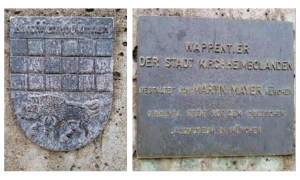Römerplatz
Old town redevelopment
In the 1970s, many German old town centers were in need of redevelopment, including Kirchheimbolanden. The idea pursued here focused on “preserving the renewal of the old town while taking into account its central importance for the town as a whole.” In order to achieve this goal, it was necessary to “preserve what is valuable from all eras and at the same time allow the buildings of our time to fit into the building structure of the town with their own design language.”
One particular urban planning task was the open space in the Schlossstrasse-Wehrgang-Holzgasse area created by the demolition of buildings and its “upgrading to a central town square with appropriate design and peripheral development”. Since its inauguration in 1991, Römerplatz has been a central place of public urban life.



City coat of arms
The town coat of arms on the base of the “Kirchheimbolander Wutz”, created by Martin Mayer (Munich) in 1998, shows a chequered pattern at the top as the coat of arms of the Counts of Sponheim and the Kirchheimbolander heraldic animal, a wild boar (Palatine: Wutz), at the bottom.
The city coat of arms can also be found on the base of the Römerplatz stage. It is also depicted on the outside of the suburban tower [Standort 01] and on the coat of arms plaque on the “Stadthaus”.
The interpretation of the coat of arms leads back to the High Middle Ages.
The Counts of Sponheim (in the Vordere Hunsrück), who have been documented since the early 13th century, also acquired property and rights in “Kirchheim” by inheritance in the middle of the 14th century.
The Sponheim chess pattern was thus transferred to their now town of Kirchheim as their stately coat of arms. Does the root of this coat of arms symbol come from the Crusades? Because the “manorial game” also reached Germany in the High Middle Ages through participants in the Crusades.
The second coat of arms image, a wild boar, probably indicates that a forest rich in game from the Donnersberg reached right up to the town and that the town wall now kept out wild boar, the hunting of which was also an exclusively noble right.
The city coat of arms can thus provide not only historical-genealogical, but also historical-geographical, legal-historical and general city-specific information.

